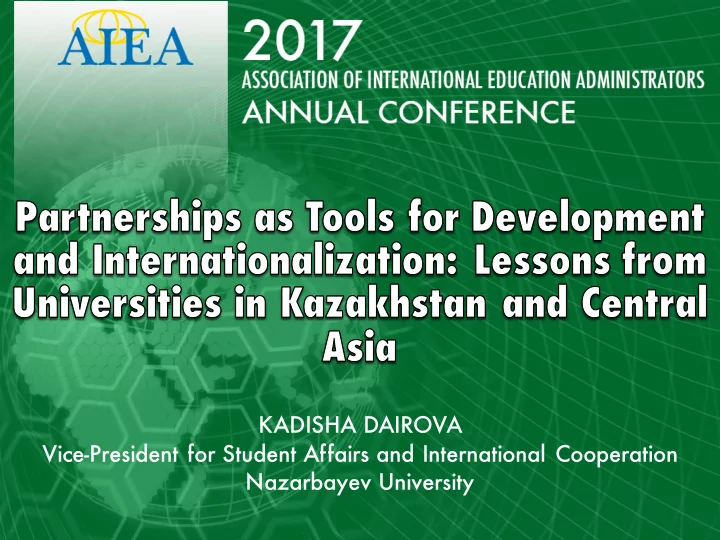

KADISHA DAIROVA Vice-President for Student Affairs and International Cooperation Nazarbayev University
Internationalization in Central Asia: Current Situation 1. Well-established academic connections; bilingual and/or trilingual education (native language, Russian, and English/Turkish…) 2. Aspects of HE impacted by internationalization: • Policy reforms and institutional change • Curriculum development • Staff and student mobility • Research 3. Major contributors to the internationalization: • Staff or faculty and student mobility • MoUs • Internships abroad • Visiting professors • Academic links with global partners 4. International standard HEIs in Central Asia: University of Central Asia with campuses in Kyrgyzstan, Kazakhstan and Tajikistan; American University of Central Asia (Kyrgyzstan); International University of Humanities and Development (Turkmenistan); Nazarbayev University, KIMEP, KBTU (Kazakhstan)
Internationalization in Central Asia: Situation across Countries Stages of internationalization process vary across Central Asian countries depending on each country’s socio-economic development: Kazakhstan has an advantage of a more balanced use of languages • of instruction (graph below). Tajikistan’s international student market is quite low and • internationalization is not highly ranked. Kyrgyzstan’s many universities are involved in internationalization, but • it impacts the simplest aspect – student and faculty mobility.
Internationalization in Central Asia: Challenges and Weaknesses 1. Systemic: centralized governance; different level of compatibility between local and international standards; lack of English language skills 2. Contextual: variations in local and national stages of development; differences in educational processes across the region; variations in levels of compliance with the Bologna framework
Internationalization in Kazakhstan 1. Signing the Bologna Declaration in 2010 and following its principles 2. More than 11 thousand Bolashak* scholars (over the last 23 years) 3. More than 6 thousand students have participated in academic mobility programs (over the last 5 years) 4. Nine universities in the QS Ranking 5. Opening of Nazarbayev University in 2010 6. Other international standard universities in Kazakhstan: KIMEP, Kazakh-British Technical University, University of Central Asia in Tekeli *President’s International Scholarship Program
Nazarbayev University (NU): Strategic Partnership Model • Established in 2010 with the aim to contribute to the establishment of Astana as an international innovation, business and knowledge hub. • Strategic partnership with world’s leading universities to develop and internationalize NU. Each partner helps NU build and develop its schools by providing support and advice in curriculum design, policy and procedures development, faculty recruitment and development, and quality assurance systems.
Nazarbayev University’s Partnership Model: Challenges and Measures CHALLENGES MEASURES 1. NU’s School of Engineering has been developed 1. Engineering curricula revision. in partnership with the British university, while 2. Development of a university-wide quality School of Science and Technology and School of framework influenced by principles of ESG 2015, Humanities and Social Sciences – with the US UK Quality Code, requirements for US universities. Engineering programs are quite institutional accreditation, etc. structured and do not allow taking courses from 3. Preparation for self-evaluation through the the other Schools. European Institution Evaluation Program in 2. Impact on academic quality culture and related Spring 2017 . policies and procedures. 4. Development of NU’s own foundation program 3. NU’s foundation program till 2015 was delivered considering advantages and disadvantages of in partnership with the University College London the previous program and involving (mirror program) and was purely British. When representatives of all undergraduate Schools. progressing to undergraduate level, faculty and students encountered certain challenges in some cases caused by limitations of the foundation program that did not always consider specifics of the American education.
Nazarbayev University: Successes 1. First graduation in 2015 : 108 out of 446 were admitted to masters and PhD programs at top universities around the world 2. NU brand (not a branch or franchise) 3. Sharing experience : successful collaboration with HEIs in Kazakhstan through participation in policy development, education programs development, delivery of training programs, organization of conferences, joint research projects, etc.
Questions to Participants 1.Are there any similar partnership models at your institutions? 2.How do you involve your international partners in internationalization of your institutions? 3.How to more effectively engage partners in student exchange programs? 4.Please, share models of joint research funding for faculty and student research?
References 1. Nazarbayev University Strategy 2013-2020 2. Stephen Hagen, “Study of the Achievements of Tempus IV Projects on the Internationalisation of Higher Education in Central Asia”, European Union, 2016 3. Yelena Istileuova, “Transformation of Higher Education in Central Asia for 20 Years”, 10th Biennial Conference of the Australasian Association for Communist and Post-Communist Studies (AACaPS) in Canberra, 3-4 February 201 1 4. Serik Irsaliyev, “Kazakhstan’s Education in the Years of Independence in the Context of Global Trends: Achievements and Perspectives for Development”, 27 October 2016 5. Geoffrey David Wilmoth, “Central Asia’s Future Role In International Higher Education”
Thank you for your attention!
Recommend
More recommend